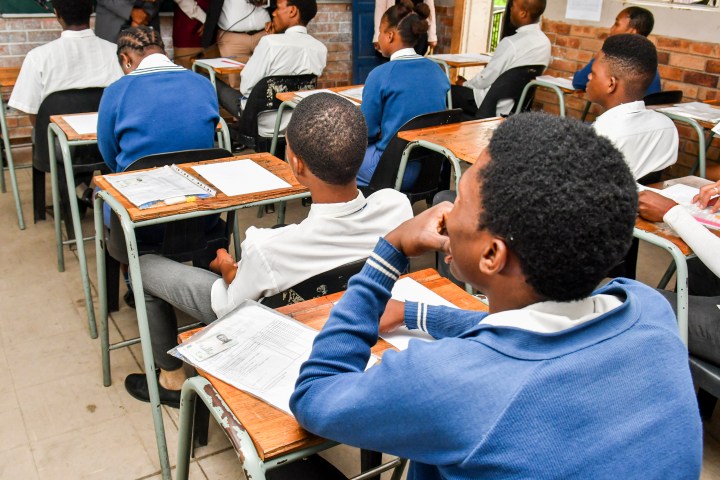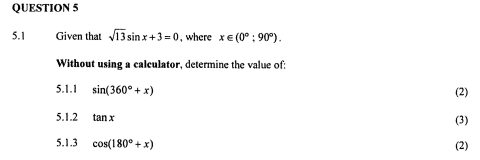EDUCATION CHALLENGES
Solving the unsolvable 5.1 problem — disastrous matric maths question stumps teachers and learners alike

In addition to the challenges of sitting for exams amid rolling blackouts, the matric class of 2022 has had to manoeuvre what has been described an ‘impossible’ trigonometry question in Mathematics Paper 2. According to grade 12 Maths teachers and learners who wrote the paper on Monday, there was an error in question 5 of the maths paper. The Department of Basic Education, meanwhile, is investigating.
“I spent most of my time in question 5 trying to figure out what is happening, and 5.1 was unsolvable.”
This comment from Thokozane Mbokazi, a grade 12 pupil of IR Lesolang Secondary School in Winterveldt, Tshwane.
Mbokazi was speaking to Daily Maverick, following an outcry over an “impossible” Mathematics Paper 2 question, which the Department of Basic Education is now investigating.
Across the country, matric pupils and maths teachers raised concerns about this equation on the Mathematics Paper 2: question 5, which reportedly compromised learners.
Even maths teachers saw the “impossible” mistake in the 5.1 question, which totalled seven marks. In total, question 5 was 30 marks of a 150-mark paper.
“Mathematics Paper 2 was depressing and it felt real. Almost everyone in the exam room seemed confused. The paper was so difficult that I can’t imagine myself in varsity next year. I was disturbed the whole day. The way questions were asked was very tricky,” said Mbokazi.
What was question 5 about?
The three-part 5.1 maths problem (5.1.1, 5.1.2 and 5.1.3) was a trigonometry question where pupils had to draw a triangle based on provided information.
However, what Daily Maverick found externally from experts is that the information provided was contradictory, and there was no way of deciding which quadrant of the Cartesian plane to draw it in, for the question.

The ‘impossible’ seven-mark question in the matric maths exam paper.
Explaining the apparent error, a Maths teacher who asked to remain anonymous, told Daily Maverick:
“I think it was a typo error or something from the examiner’s side. In the opening statement of question 5, the error was a + instead of a – just before the 3.
“That mistake led to learners not identifying the correct quadrant because they had to solve it with the aid of the diagram. But [they] could not identify the correct diagram, given the error on the paper. As a result, question 5.1 is unsolvable… I tried solving it myself but just couldn’t. I can only wonder how much time pupils wasted trying to solve it.”
A number of other maths scholars corroborated this view that the seven-mark 5.1 question was impossible to solve.
Now questions are raised about how the apparent error got past the quality checks and moderators of the National Senior Certificate (NSC). Meanwhile, the Department of Basic Education said it’s investigating the matter.
______________________________
Visit Daily Maverick’s home page for more news, analysis and investigations
______________________________
Elijah Mhlanga, the DBE spokesperson, told New24 that learners shouldn’t worry as the department will “look into it”.
“We have a panel that reviews every paper. If there is an error, the first step is to remove that mark so that no one is compromised. If an error has been declared, we will tell markers to ignore question 5 so that everyone is covered and there is fairness. As the exam was out of 100, everyone will be marked on 93. The second step is to check what the impact was on the pupils.”
Mhlanga further said officials would look at the overall performance of the learners. If it is established that the question impacted their exam, the department will ask the quality assurance Umalusi Council for an upward adjustment of 1% or 2%.

Learners at Mandlenkosi High School. (Photo by Gallo Images/Darren Stewart)
Daily Maverick sent the following questions to Mhlanga;
- What do preliminary findings of the Department of Basic Education’s investigation suggest? Is there an error with the question?
- If there is an error with the question, how was it possible for the examiners to set an impossible mathematics question for matric exams that goes past quality checks or assurance, only to be discovered on the day of the exam?
- Surely a panel of proofreaders should have seen there was amiss with the question. Learners panicked and wasted valuable time they could have spent solving other questions. How is adjusting marks upward by 1% or 2% a solution when the impact is done?
His response was that “the Minister of Basic Education will address the media on Sunday morning and respond to all questions regarding this matter”.
Mbokazi told Daily Maverick that question 5 wasn’t the only problem he and fellow matric learners had to deal with.
“The diagrams in question 9 had a lot of lines and that made it more confusing. But I don’t think my performance will be bad, because some of the questions were solvable. The only thing I did was apply the knowledge that I got from the beginning of the year. The feeling with my classmates is mutual, no one was happy on that day.”
Update on Sunday, 13 November, 2022: Daily Maverick has been contacted by a mechanical engineer who insisted there was nothing confusing about the question, and complaints were “largely an emotive response by disappointed students who weren’t properly taught or prepared”.
However, here is an assessment from Nicky Roberts, a professor of mathematics education at the University of Fort Hare, and director of Kelello Consulting. She concludes that the question is impossible to solve:

Assessment by Maths Professor Nicky Roberts.
DM
Daily Maverick urges the department to respond to the matter as a matter of urgency.


















 Become an Insider
Become an Insider
Must be missing something, since I cannot see why this is difficult to solve. Angle x is acute so all the usual trig functions apply. Using Pythagoras the adjacent side of the triangle is 2 so tan(x) is straightforward (-3/2). Using the addition formulae and sin(180) = sin(360) = 0, cos(360)=1, cos(180)=-1 the other two parts are easy (1: -3/root(13), 3: -2/root(13)
You didn’t take into account the given range. For 0° ≤ x ≤ 90°, sin(x) ≥ 0 everywhere. It cannot be -3/√13, as stated. (Johan Buys’s proposal, to take the negative root of 13, doesn’t work, because the radius of a circle cannot be negative.) In the given range, 0 ≤ tan(x) ≤ ∞, so your answer -3/2 is incorrect.
The anonymous maths teacher is right: the plus in the given equation should be a minus. That makes sin(x) = 3/√13, which gives you the first-quadrant triangle x=2, y=3, and r=√13, from which the answers follow:
5.1.1. sin(x+360°) = sin(x) = 3/√13;
5.1.2. tan(x) = y/x = 3/2;
5.1.3. cos(x+180°) = -cos(x) = -x/r = -2/√13.
Johan Buys’ solution does work. There is an x in the range such that -sqrt(13)*sin(x)+3=0, where I have added the minus sign to make it explicit. It doesn’t mean there has to be a negative radius.
The question says the angle is in the first quadrant because the angle is between 0 and 90. For this reason, there cannot be a minus sign as all values are positive in the first quadrant. This means that author is correct that there was no quality control of the paper and in particular the question. Removing the marks will not actually bring back the time taken by students to find a solution nor the train of thought when writing an exam that may have affected other questions. The best solution would be to rewrite the paper as a single question affects others because of the amount of time taken on the question which has no solution as there is no negative value in the first quadrant. The other alternative is to first look at the overall performance on the paper without the question and if it is less than 60 then rewrite the paper.
Would it help if one takes the view that the square of anything can be positive or negative? Eg 49 can be 7 or -7 and since 13 is more than 9 then sin(x) will, correctly, always be a number between 0 and 1???? about -3/-3.6 = .83 so x is most definitely both logical and it exists.
The real challenges were questions 9 and 10. Maths tutors are still battling to figure those questions out. This article should have considered wider opinions and be approached holistically. Many learners identified the mistake, in question 5.1, corrected it and solved the question. Not marking 5.1 would also be unfair.
People are stuck on SQRT. If the equation were given K x Sin X + 3 = 0, where k^2=13 then there would be no drama. You don’t need to solve k because you can answer the questions with k^2 value, the known 13
a square root can be positive or negative, and we are told x is in the first quadrant. Therefore we use the negative square root of 13 and sin(x) is sqrt (13)/3. The third side of the right triangle, using Pythagoras, is 2 so tan (x) is 3/2 or 1.5.
It is a bit tricky, requiring perhaps a little out the box thought, but it is solvable.
I can’t really get past the view that the maths examiner is trying to prove how clever he / she is by tricking students (under a lot of stress and pressure) into making mistakes by setting ‘clever’ questions. Not only do smart students waste time because they think they SHOULD be able to answer the question, but struggling students also get confused and lose confidence. Where is your humanity man? Have you forgotten the stress of trying to do well in exams, especially if you’re not brilliant? Not to mention that a moderator should actually write the exam, instead of saying, ‘Ja, I think it’s OK.’ Standard of teaching, and examining is extremely poor across the board from fancy private schools all the way down.
Actually checking the paper to see if it’s good is exactly the moderators job.
It’s the examiners job to set the paper.
Having these as two separate persons is better as the person who set the paper is less likely to notice their own errors